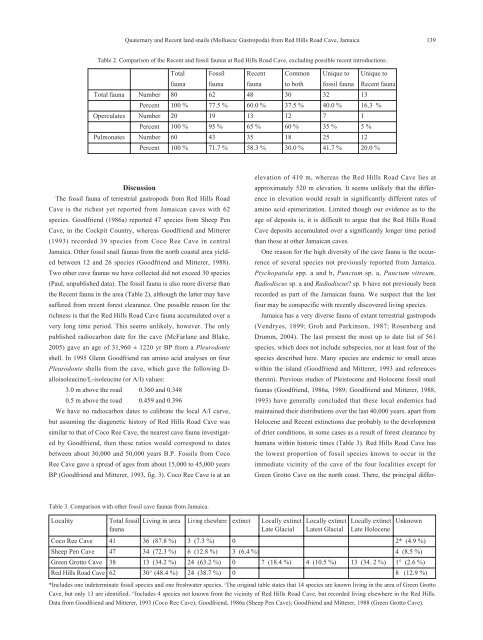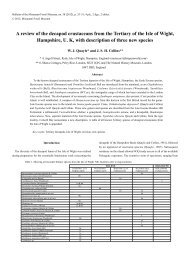Quaternary and Recent land snails (Mollusca: Gastropoda) from ...
Quaternary and Recent land snails (Mollusca: Gastropoda) from ...
Quaternary and Recent land snails (Mollusca: Gastropoda) from ...
You also want an ePaper? Increase the reach of your titles
YUMPU automatically turns print PDFs into web optimized ePapers that Google loves.
<strong>Quaternary</strong> <strong>and</strong> <strong>Recent</strong> l<strong>and</strong> <strong>snails</strong> (<strong>Mollusca</strong>: <strong>Gastropoda</strong>) <strong>from</strong> Red Hills Road Cave, Jamaica 139<br />
Table 2. Comparison of the <strong>Recent</strong> <strong>and</strong> fossil faunas at Red Hills Road Cave, excluding possible recent introductions.<br />
Total Fossil <strong>Recent</strong> Common Unique to Unique to<br />
fauna fauna fauna to both fossil fauna <strong>Recent</strong> fauna<br />
Total fauna Number 80 62 48 30 32 13<br />
Percent 100 % 77.5 % 60.0 % 37.5 % 40.0 % 16.3 %<br />
Operculates Number 20 19 13 12 7 1<br />
Percent 100 % 95 % 65 % 60 % 35 % 5 %<br />
Pulmonates Number 60 43 35 18 25 12<br />
Percent 100 % 71.7 % 58.3 % 30.0 % 41.7 % 20.0 %<br />
Discussion<br />
The fossil fauna of terrestrial gastropods <strong>from</strong> Red Hills Road<br />
Cave is the richest yet reported <strong>from</strong> Jamaican caves with 62<br />
species. Goodfriend (1986a) reported 47 species <strong>from</strong> Sheep Pen<br />
Cave, in the Cockpit Country, whereas Goodfriend <strong>and</strong> Mitterer<br />
(1993) recorded 39 species <strong>from</strong> Coco Ree Cave in central<br />
Jamaica. Other fossil snail faunas <strong>from</strong> the north coastal area yielded<br />
between 12 <strong>and</strong> 26 species (Goodfriend <strong>and</strong> Mitterer, 1988).<br />
Two other cave faunas we have collected did not exceed 30 species<br />
(Paul, unpublished data). The fossil fauna is also more diverse than<br />
the <strong>Recent</strong> fauna in the area (Table 2), although the latter may have<br />
suffered <strong>from</strong> recent forest clearance. One possible reason for the<br />
richness is that the Red Hills Road Cave fauna accumulated over a<br />
very long time period. This seems unlikely, however. The only<br />
published radiocarbon date for the cave (McFarlane <strong>and</strong> Blake,<br />
2005) gave an age of 31,960 ± 1220 yr BP <strong>from</strong> a Pleurodonte<br />
shell. In 1995 Glenn Goodfriend ran amino acid analyses on four<br />
Pleurodonte shells <strong>from</strong> the cave, which gave the following Dalloisoleucine/L-isoleucine<br />
(or A/I) values:<br />
3.0 m above the road 0.360 <strong>and</strong> 0.348<br />
0.5 m above the road 0.459 <strong>and</strong> 0.396<br />
We have no radiocarbon dates to calibrate the local A/I curve,<br />
but assuming the diagenetic history of Red Hills Road Cave was<br />
similar to that of Coco Ree Cave, the nearest cave fauna investigated<br />
by Goodfriend, then these ratios would correspond to dates<br />
between about 30,000 <strong>and</strong> 50,000 years B.P. Fossils <strong>from</strong> Coco<br />
Ree Cave gave a spread of ages <strong>from</strong> about 15,000 to 45,000 years<br />
BP (Goodfriend <strong>and</strong> Mitterer, 1993, fig. 3). Coco Ree Cave is at an<br />
Table 3. Comparison with other fossil cave faunas <strong>from</strong> Jamaica.<br />
elevation of 410 m, whereas the Red Hills Road Cave lies at<br />
approximately 520 m elevation. It seems unlikely that the difference<br />
in elevation would result in significantly different rates of<br />
amino acid epimerization. Limited though our evidence as to the<br />
age of deposits is, it is difficult to argue that the Red Hills Road<br />
Cave deposits accumulated over a significantly longer time period<br />
than those at other Jamaican caves.<br />
One reason for the high diversity of the cave fauna is the occurrence<br />
of several species not previously reported <strong>from</strong> Jamaica.<br />
Ptychopatula spp. a <strong>and</strong> b, Punctum sp. a, Punctum vitreum,<br />
Radiodiscus sp. a <strong>and</strong> Radiodiscus? sp. b have not previously been<br />
recorded as part of the Jamaican fauna. We suspect that the last<br />
four may be conspecific with recently discovered living species.<br />
Jamaica has a very diverse fauna of extant terrestrial gastropods<br />
(Vendryes, 1899; Groh <strong>and</strong> Parkinson, 1987; Rosenberg <strong>and</strong><br />
Drumm, 2004). The last present the most up to date list of 561<br />
species, which does not include subspecies, nor at least four of the<br />
species described here. Many species are endemic to small areas<br />
within the isl<strong>and</strong> (Goodfriend <strong>and</strong> Mitterer, 1993 <strong>and</strong> references<br />
therein). Previous studies of Pleistocene <strong>and</strong> Holocene fossil snail<br />
faunas (Goodfriend, 1986a, 1989; Goodfriend <strong>and</strong> Mitterer, 1988,<br />
1993) have generally concluded that these local endemics had<br />
maintained their distributions over the last 40,000 years, apart <strong>from</strong><br />
Holocene <strong>and</strong> <strong>Recent</strong> extinctions due probably to the development<br />
of drier conditions, in some cases as a result of forest clearance by<br />
humans within historic times (Table 3). Red Hills Road Cave has<br />
the lowest proportion of fossil species known to occur in the<br />
immediate vicinity of the cave of the four localities except for<br />
Green Grotto Cave on the north coast. There, the principal differ-<br />
Locality Total fossil Living in area Living elsewhere extinct Locally extinct Locally extinct Locally extinct Unknown<br />
fauna Late Glacial Latest Glacial Late Holocene<br />
Coco Ree Cave 41 36 (87.8 %) 3 (7.3 %) 0 2* (4.9 %)<br />
Sheep Pen Cave 47 34 (72.3 %) 6 (12.8 %) 3 (6.4 %) 4 (8.5 %)<br />
Green Grotto Cave 38 13 (34.2 %) 24 (63.2 %) 0 7 (18.4 %) 4 (10.5 %) 13 (34. 2 %) 1° (2.6 %)<br />
Red Hills Road Cave 62 30^ (48.4 %) 24 (38.7 %) 0 8 (12.9 %)<br />
*Includes one indeterminate fossil species <strong>and</strong> one freshwater species. o The original table states that 14 species are known living in the area of Green Grotto<br />
Cave, but only 13 are identified. ^Includes 4 species not known <strong>from</strong> the vicinity of Red Hills Road Cave, but recorded living elsewhere in the Red Hills.<br />
Data <strong>from</strong> Goodfriend <strong>and</strong> Mitterer, 1993 (Coco Ree Cave); Goodfriend, 1986a (Sheep Pen Cave); Goodfriend <strong>and</strong> Mitterer, 1988 (Green Grotto Cave).





